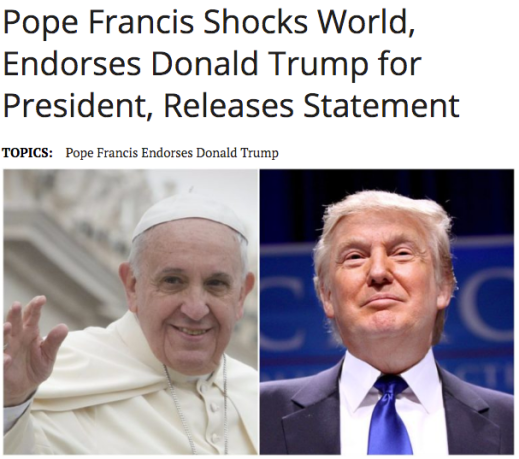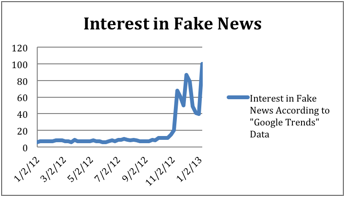By Kay Mathiesen and Don Fallis
In our last blog post, we concluded that most fake news is bullshit rather than disinformation. But we reached the conclusion using the dictionary definition of disinformation. And there is reason to think that the dictionary definition is too narrow.
Most fake news is not disinformation according to the dictionary definition because most purveyors of fake news don’t intend to mislead anybody. (They just want to make money.) But Professor Fallis (2015) has argued that, when we define disinformation, we should not require that someone intend to mislead someone else. Instead, we should only require that it be no accident that people are misled.
There are species of insects that have evolved to look like sticks or leaves. These insects do not consciously intend potential predators to believe that they are flora rather than fauna. However, it is no accident that potential predators are fooled. The deceptive camouflage gives these insects an adaptive advantage. In particular, they are less likely to be eaten. As a result, the deceptive camouflage is more likely to continue into the future (because the genes that create it will be passed on to future generations). Thus, even though there is no intention to deceive, it still seems like these insects are producing disinformation. Professor Fallis (2015) calls it adaptive disinformation (as opposed to intentional disinformation).
Note: Sometimes, people don’t get the joke and are fooled by what they read in The Onion. But that doesn’t make it adaptive disinformation. It is just an accident that such gullible people are misled by The Onion.
Humans can give a false impression of themselves in the same sort of way. Here’s an example: At a recent conference on deception, we met a woman who had grey hair. She told us that she had dyed her hair brown a while back. Unlike the stick insect, this woman intentionally changed her appearance. But just like the stick insect, she did not *intend* to mislead anyone about her age. The woman just dyed hair because she wanted a change. Nevertheless, she was surprised to discover that many people were misled about her age and that they started paying more attention to her. And since she enjoyed the extra attention, this woman continued to dye her hair brown, and more people were misled. Thus, just like with the stick insect, there was a reinforcement mechanism that led to people being misled even though no one intended that this happen.
Note: Professor Fallis has recorded a video that discusses other examples of humans producing adaptive disinformation.
In a similar vein, even if purveyors of fake news don’t intend to mislead anybody, it is no accident that people are misled by their stories. People being misled serves a function. Because the purveyors of fake news want to make money, they want people to click on their stories, and to share their stories with other people who might also click on them. And people are more likely to click and to share crazy stories about Trump and Clinton if they believe those stories. In other words, the more people that believe, the more money that is made. Moreover, the more money that is made, the more people that get into the business of producing fake news. Thus, even though purveyors of fake news may not care whether their stories are true or false or whether people believe them, there is a reinforcement mechanism that leads to people being misled by fake news.
Note: Unlike the stick insect, the purveyors of fake news intentionally created their stories. It is just that they do not necessarily intend to mislead anyone by doing so.
Now, some purveyors of fake news may be sophisticated enough to realize that people are more likely to click and to share their stories if they believe those stories. Such purveyors do intend that people believe their stories. In other words, they intend people to have false beliefs. Thus, while the reinforcement mechanism is still in play, such purveyors are producing intentional (i.e., dictionary definition) disinformation.
However, purveyors of fake news in general are not, and need not, be aware that people are more likely to click and to share their stories if they believe those stories. They may just find through trial-and-error that they can achieve their goal of generating traffic by writing certain sorts of outrageous stories. “The best way to generate shares on Facebook is to publish sensationalist and often false content that caters to Trump supporters … some in Veles experimented with left-leaning or pro–Bernie Sanders content, but nothing performed as well on Facebook as Trump content.” Purveyors of fake news need not understand fully why certain sorts of stories are so effective at generating traffic. Thus, they need not intend people to believe their stories. So, while they are producing disinformation, it is adaptive rather than intentional.
Note: Some purveyors of fake news actually wanted Clinton rather than Trump to win the election. So, they did not really want people to believe their outrageous stories about Clinton’s alleged misdeeds.
Admittedly, having people believe their crazy stories serves their interests just like it serves the interests of those purveyors who, for instance, do care about the outcome of elections. But even though people believing their stories furthers their goal of generating traffic, it is not part of what they actually intend. As lawyers would put it, there is no mens rea (or “guilty mind”).
Note: Purveyors of fake news do have a “guilty mind” insofar as they intend people to believe that their websites are legitimate. But they do not necessarily intend people to believe what those websites say.
Now, in the cases of adaptive disinformation that Professor Fallis (2015) discusses, the falsity of the belief is an essential part of the reinforcement mechanism. For instance, stick insects look like sticks because this appearance falsely suggests to predators that they are just sticks. But it is not clear that falsity plays the same role in the spread of fake news. Unlike with the stick insect’s appearance, the fact that these stories are false is not part of what increases the spread of these stories. These stories spread because they are so interesting, so surprising, and fit so well the preconceptions of a certain segment of the population. Indeed, the purveyors of fake news would still disseminate the same crazy story about Trump or Clinton even if they found out that it was true.
But it is important to note that most of these outrageous stories are false. There are not enough crazy stories about Trump and Clinton that are true to keep the purveyors of fake news in business. Thus, the properties of these stories that do increase their spread are highly correlated with these stories being false. So, it is still no accident that people are misled by fake news.
Note: While there may be a few crazy stories about Trump and Clinton that are true and that would generate traffic, it is not cheap to hire journalists to uncover these stories. So, it is not really cost-effective for the purveyors of fake news to peddle truth to their readers.
References:
- Fallis, Don (2015). “What is Disinformation?” Library Trends, 63(3), 401-426.
Discussion Questions:
- Is there any fake news that is not at least adaptive disinformation?
- Is adaptive disinformation any less dangerous than intentional disinformation?








